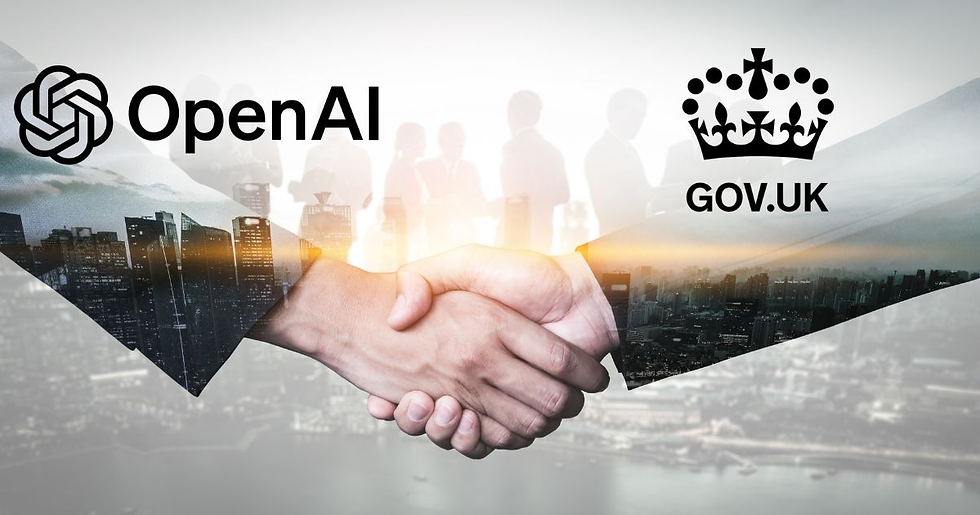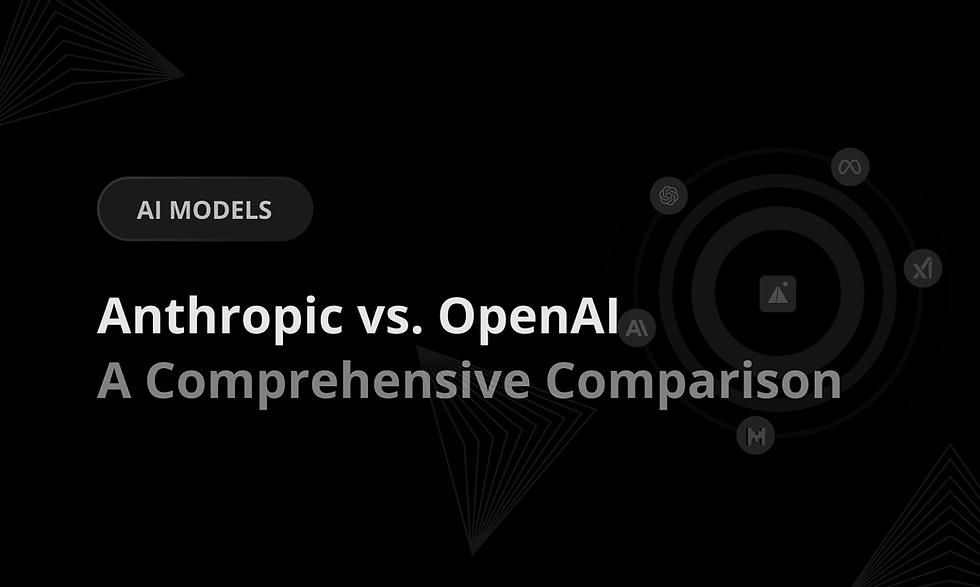UK Government in Talks with OpenAI for Nationwide ChatGPT Plus Access
- Ethan Carter

- Aug 25
- 15 min read

UK Government in Talks with ChatGPT Plus Access — overview and relevance
The UK government has entered negotiations with OpenAI to secure ChatGPT Plus access across government departments as part of a push to modernise public services and strengthen national AI infrastructure. This move seeks to move conversational AI from isolated pilots into a coordinated, government-wide capability that departments can rely on for both citizen-facing services and internal productivity gains. The government framed the collaboration as a way to “turbocharge the UK’s AI infrastructure and transform public services”, while OpenAI emphasised expanded local commitment and support for UK departments as part of a strategic partnership.
Why this matters now: the timing aligns with the UK’s national AI strategy and a broader industry shift from experimental deployments to scaled adoption. Governments worldwide are trying to capture productivity benefits from generative AI while containing risks. Securing nationwide ChatGPT Plus access would give departments the higher-availability, priority-rate features that matter for high-volume public services and create a common baseline for integration, procurement and governance.
Immediate expected benefits include faster citizen interactions, scaled automation of routine processes, and shared tooling for drafting, summarisation and knowledge retrieval. High-level risks include data security and sovereignty questions, potential bias in automated outputs, procurement and vendor-lock‑in concerns, and workforce impacts from changing job tasks.
Insight: a centrally negotiated arrangement for ChatGPT Plus access could accelerate adoption and lower duplication — but success will depend on robust technical integration, procurement safeguards and governance.
What you will learn in this article: the formal scope of the partnership and what OpenAI is committing in the UK; how nationwide ChatGPT Plus access could change citizen services and back-office productivity; technical and security implications; policy, ethics and governance requirements; practical pilots and rollout scenarios; workforce impacts and mitigation strategies; and concise FAQs and actionable next steps for policy makers, IT leaders and journalists.
Key takeaway: this is a strategic partnership that aims to scale conversational AI across government — it presents a substantial efficiency opportunity, but the benefits hinge on how data, security and governance are handled.
Partnership details and scope, OpenAI expansion and government collaboration

What the announcement says
Both sides described the arrangement as a strategic partnership that includes OpenAI expanding its UK presence and working directly with government departments on pilots and integration. The government described the plan as a programme to “work with government departments to turbocharge the UK’s AI infrastructure and transform public services” with an expanded OpenAI office in the UK. OpenAI’s statement emphasised local teams, technical support for departments, and collaboration on security and infrastructure goals. Media reporting framed this as a negotiated commercial and technical arrangement rather than an immediate procurement — a staged approach to pilots and capability-building is expected.
Insight: the partnership blends a commercial vendor agreement with public-sector commitments to infrastructure and oversight.
Actionable takeaway: establish a clear cross-department steering group now to coordinate pilots, share requirements and avoid duplicated procurement.
What OpenAI is committing to in the UK
OpenAI has committed to expanding its UK office and growing local teams that can directly support government departments. Reporting indicates commitments include hands-on technical support for integrations, local engineering or customer-success resources, and participation in joint pilot programmes. Reuters covered the strategic partnership and highlighted OpenAI’s expansion plans in the UK. These local resources are intended to shorten feedback loops, provide rapid incident response and help tailor deployments to UK legal and operational requirements.
Example: a dedicated OpenAI team embedded with an HMRC or Department of Work & Pensions project could accelerate secure API integrations and troubleshooting during a pilot.
Actionable takeaway: define desired levels of local support (SLA hours, response times, on-site options) in early statements of work to avoid ambiguous expectations.
Government commitments and intended outcomes
The government is signalling objectives such as modernising service delivery, improving response times, and upgrading AI-ready infrastructure across departments. Public messaging stresses measurable outcomes like faster handling of citizen queries and more robust national AI infrastructure. ComputerWorld characterised the deal as part of broader efforts to modernise UK government services using OpenAI’s capabilities. Departments will likely be asked to identify target processes for automation, agree KPIs and open channels for security and compliance review.
Actionable takeaway: require pilots to include baseline metrics (e.g., average response time, manual handling rate) and a clear “go/no-go” decision point based on those KPIs.
Reported timelines and next steps
Coverage points to staged timelines: immediate expansion of local OpenAI staff, short-term pilots with selected departments, then a phased rollout if pilots meet success criteria. Reuters reported the strategic partnership announcement and suggested initial departmental engagements are expected soon after the announcement. The government’s procurement and security reviews will shape exact schedules.
Example timeline: 0–3 months — establish governance and select pilot teams; 3–9 months — run pilots and evaluate KPIs; 9–18 months — phased departmental rollouts and infrastructure upgrades.
Actionable takeaway: publish a rolling 12-month roadmap with clear milestones and public checkpoints to sustain accountability and stakeholder confidence.
Key takeaway: the partnership is structured as a staged, supported expansion with measurable pilots and local OpenAI presence — timelines depend on security reviews and pilot outcomes.
What nationwide ChatGPT Plus access means for public services and citizen experience

Nationwide ChatGPT Plus access would provide departments with priority API usage, faster response characteristics and predictable capacity that matter for high-traffic public services. These capabilities can materially alter both citizen-facing interactions and back-office work. CNBC covered the partnership’s emphasis on security and infrastructure as a means to scale OpenAI capabilities within the UK public sector. ComputerWeekly discussed readiness of public and private sectors and how products like ChatGPT are being adapted for institutional use.
Insight: priority access and higher-throughput tiers can make conversational AI viable for 24/7 helplines and real-time workflows that pilots on free tiers could not sustain.
Actionable takeaway: when planning channels, prioritise high-volume services (tax, benefits, health advice) where latency and throughput matter most.
Citizen-facing services and improved access
Concrete changes for citizens could include faster answers to routine queries, guided form completion, and multi-channel conversational support (web chat, SMS, voice assistants). A central ChatGPT Plus access arrangement helps ensure consistent response quality and lower downtime. Example applications: an automated benefits eligibility checker that interprets citizen inputs and returns tailored next steps, or an NHS triage assistant that rapidly filters non-urgent queries and directs callers appropriately.
Example: a local authority could deploy a ChatGPT Plus–backed chat widget that reduces average wait time from 12 minutes to under 2 minutes for common enquiries.
Measuring success: track average first-response time, percentage of queries deflected from human agents, and citizen satisfaction scores.
Actionable takeaway: design pilot citizen journeys with explicit fallbacks to human agents and include accessibility testing for users with disabilities.
Back-office automation and productivity
Inside government, conversational AI can support drafting responses to Freedom of Information requests, summarising long case files, assisting policy teams with rapid literature reviews, and providing on-demand policy lookups. Priority access reduces interruptions during business hours and enables higher concurrency for internal teams.
Example: policy analysts could reduce literature-synthesis time from days to hours by using a controlled summarisation workflow that feeds outputs to subject-matter experts for verification.
Measuring success: measure time-to-draft, reduction in repetitive tasks, and reallocation of staff time to higher-value activities.
Actionable takeaway: pair AI-assisted drafting with human review rules and versioned audit trails to maintain quality and accountability.
Measuring impact on user experience
Suggested KPIs to evaluate nationwide ChatGPT Plus access include:
Average response time for citizen queries.
Resolution or deflection rate (percentage handled without human escalation).
Citizen satisfaction and Net Promoter Score changes.
Reduction in staff processing time for routine tasks.
Incident rates related to incorrect or biased outputs.
Example metric goal: achieve a 40% reduction in average handling time for routine helpline queries within six months of a pilot.
Actionable takeaway: align KPIs across departments to permit comparison and shared learning while allowing role-specific metrics for specialised services.
Key takeaway: nationwide ChatGPT Plus access can deliver tangible improvements in responsiveness and productivity, but measurable pilots and human oversight are required to ensure quality and fairness.
Technical integration, security and UK AI infrastructure implications

Scaling ChatGPT Plus access in government requires careful technical design: API management, identity and access integration, latency-sensitive routing, SLA-backed uptime and structured logging for auditability. The government announcement highlighted work on infrastructure transformation with OpenAI that aims to address these operational needs. The government set out ambitions for infrastructure upgrades as part of its collaboration with OpenAI to support public services. Academic analysis also raises important questions about the UK as a data provider and hosting responsibilities for safe AI use. An arXiv analysis explored the role of UK data in training and evaluation and the implications for national data governance.
Insight: reliable, secure API integration and clear data flows will be the linchpin of any successful nationwide deployment.
Actionable takeaway: require detailed integration runbooks and baseline SLAs as part of any department-level agreement.
Integration architecture and deployment models
Options for deployment include:
Cloud-hosted APIs with strict tenancy and network controls.
Private instances or enterprise offerings that can be run in sovereign or hybrid environments.
Hybrid models that keep sensitive workloads on-premises while using hosted models for non-sensitive tasks.
Key integration components: API gateways, rate-limiting, observability (metrics and traces), identity federation (single-sign-on/SSO) with role-based access control, and robust CI/CD for prompt model updates.
Example: a hybrid model where citizen-submitted personal data is redacted and routed to a private, government-controlled environment for processing, while general knowledge queries use hosted APIs with priority access.
Actionable takeaway: map all integration points and create zone-based controls (sensitive vs non-sensitive) before any pilot goes live.
Security controls and compliance requirements
Security measures reported and expected include encryption in transit and at rest, comprehensive audit logs, secure enclaves for sensitive processing, and red teaming of components to discover vulnerabilities. Departments will need incident response playbooks that integrate vendor and government teams.
Example controls: mandatory TLS for all API calls, cryptographic key management under government control, and role-scoped tokens with short lifespans for service accounts.
Actionable takeaway: include vendor obligations for breach notification timelines, logging retention policies and routine penetration testing in contracts.
Data governance and provenance
Determining whether and how government data might be used for model training or benchmarking is critical. The arXiv discussion flagged that national datasets can influence models’ behaviour and raised provenance and minimisation concerns. An arXiv analysis discussed how national data contributions affect training and evaluation and why explicit controls matter for public-sector usage. Government agreements should explicitly state data-use limitations, redaction standards, retention windows and whether data can be used for model improvement.
Example: a policy that no identifiable citizen data leaves a closed government environment unless explicitly consented and logged, and that synthetic or anonymised datasets are used for model evaluation instead.
Actionable takeaway: codify a “data minimisation and non‑training” clause for sensitive data in core contracts, with audited attestations from the vendor.
Key takeaway: technical integration and security must be planned hand-in-hand — architecture choices determine how well privacy, uptime and auditability goals can be met.
Policy, ethics and governance for ChatGPT Plus access in the public sector

Deploying ChatGPT Plus access across government introduces policy and ethical obligations that extend beyond typical IT projects: transparency, accountability, bias mitigation, auditability and citizen redress. Scholarly work on generative AI in the public sector highlights the need for governance frameworks tailored to the unique risks of language models. An arXiv study examined the governance challenges of generative AI in public administration and recommended transparency and testing regimes. The Financial Times has also emphasised the strategic and national implications of AI partnerships and the need for clear oversight. The Financial Times discussed how national AI strategy and partnerships shape long-term public policy and accountability choices.
Insight: legal compliance alone is not sufficient — demonstrable fairness, explainability and public reporting build legitimacy.
Actionable takeaway: mandate independent audits and public reporting for any department deploying large-language-model-based services.
Ethical safeguards and bias mitigation
Departments must implement continuous bias testing, domain-specific evaluation datasets, and processes for correcting discovered harms. This includes regular fairness audits, stress tests with edge cases, and an explicit complaint and redress process for affected citizens.
Example: run pre-deployment bias scans on representative datasets for benefits claims and monitor post-deployment for complaint patterns indicating systemic issues.
Actionable takeaway: require routine third-party bias audits as a contractual condition.
Legal and regulatory compliance
Key legal frameworks include UK GDPR for data protection, freedom of information considerations for automated decision-making, and procurement regulations that govern vendor selection and contract terms. Transparency obligations — for example, disclosing when citizens are interacting with an AI and providing human review paths — must be embedded in service design.
Example: implement automated tagging for AI-generated content so that responses include an explicit statement when they are produced or assisted by AI.
Actionable takeaway: create a standard legal checklist for AI deployments covering consent, data minimisation, FOI implications and procurement compliance.
Oversight mechanisms and transparency
Effective oversight requires logging, explainability mechanisms (at least for policy decisions), routine red-teaming and public reporting on outcomes and incidents. Roles should be clearly assigned: government as regulator and customer, OpenAI as vendor responsible for contractual obligations, and independent auditors or academic partners for verification.
Example: publish anonymised quarterly summaries of pilot outcomes, incidents and corrective actions to maintain public trust.
Actionable takeaway: convene an independent oversight panel to review pilot results and recommend policy adjustments.
Key takeaway: ethical deployment requires mandatory audits, transparency to users and legal safeguards — these are essential to maintain public trust and legal compliance.
Case studies and early adoption scenarios for ChatGPT Plus across UK departments

This section presents plausible pilots and scenarios where ChatGPT Plus access could be trialled to assess value and risks. OpenAI’s partnership announcement emphasises joint pilots with government departments to explore practical uses. For scale context, public ChatGPT adoption statistics help model likely usage patterns and concurrency needs. Usage trends reported by industry trackers give a sense of ChatGPT’s user base growth and peak concurrency demands that planners should consider.
Insight: early pilots should focus on high-volume, lower-risk processes with clearly measurable outcomes.
Actionable takeaway: select 3–5 pilot use cases across different risk profiles (low, medium, high) and apply a uniform evaluation framework.
Example pilot: citizen helpline automation
Goal: reduce average wait times and deflect routine queries while preserving human oversight for complex cases.
Integration steps: 1. Integrate ChatGPT Plus access behind the helpline chat widget with authentication and logging. 2. Configure content filters and escalation rules for uncertain responses. 3. Run a shadow period where AI suggestions are reviewed by human agents before live deployment.
Expected outcomes and KPIs: 30–50% reduction in average wait time for routine queries, 20–30% deflection rate from human agents, and maintained or improved citizen satisfaction.
Actionable takeaway: run an A/B test comparing AI-assisted and human-only workflows to quantify impacts.
Example pilot: internal knowledge management
Use case: provide fast summaries of lengthy policy documents and enable natural-language search across internal knowledge bases.
Implementation steps: 1. Ingest policy documents into a secure retrieval-augmented generation (RAG) pipeline with provenance links. 2. Enable role-based access and logging for all queries. 3. Monitor accuracy and provide editors to approve outputs for high-stakes use.
Expected outcomes: reduce time to find and summarise relevant policy material by 40–60%, enabling faster briefing cycles.
Actionable takeaway: enforce a “human verification before publication” rule for all AI-generated policy summaries.
Scaling from pilot to nationwide access
Criteria for scaling should include:
Meeting or exceeding KPIs for reliability, accuracy and satisfaction.
Passing security and privacy audits, including proof of controls for sensitive data.
Having a sustainable operational model (support, monitoring, incident response).
Clear procurement terms to enable departmental onboarding.
Resource planning: central funding for shared infrastructure, a cross-department ops team, and vendor-managed SLA commitments.
Actionable takeaway: define explicit scaling gates (technical, security, fiscal) and confirm budget and resource commitments before expanding beyond pilots.
Key takeaway: pilots should be targeted, measurable and designed to produce comparable results across departments to inform scale decisions.
Challenges, solutions and workforce implications for ChatGPT Plus adoption

Adopting ChatGPT Plus access across the public sector raises a range of challenges — technical, ethical and workforce-related — that require coordinated solutions. ComputerWeekly’s industry coverage explores public-sector readiness and deployment considerations for LLMs in institutional contexts. CNBC’s coverage emphasised security and the need for upgraded infrastructure to support scaled deployments.
Insight: the technology’s upside depends on simultaneous investment in security, governance and people.
Actionable takeaway: create a cross-government risk register and remediation roadmap before authorising broad access.
Technical and operational risk mitigation
Main technical risks: data leakage, model hallucinations (incorrect assertions), vendor outages, and integration complexity.
Practical mitigations:
Isolate sensitive workloads to private or on-premise environments.
Use redaction and anonymisation for inputs containing personal data.
Implement staged rollouts and circuit-breakers to halt problematic behaviour.
Maintain fallback human workflows for mission-critical services.
Example: route PII-containing requests to an internal service that redacts and only then forwards non-sensitive context to the hosted model.
Actionable takeaway: require technical runbooks and emergency rollback procedures from vendors.
Ethical and social risk responses
Main ethical risks: biased outputs, unfair outcomes for vulnerable groups and opaque decision-making.
Responses:
Conduct pre- and post-deployment fairness testing using representative datasets.
Create public-facing explainability pages that describe how AI is used in a service.
Implement complaint mechanisms and remediation pathways for citizens.
Example: maintain a public log of policy exceptions and corrective actions following bias incidents.
Actionable takeaway: establish mandatory impact assessments for any deployment affecting citizen entitlements.
Workforce transformation and training
Adoption will change roles rather than simply eliminate them. Staff will shift from repetitive tasks to oversight, exception handling and higher-value activities.
Training approaches:
Provide targeted reskilling for tasks like AI supervision, prompt engineering and quality assurance.
Introduce internal AI champion networks to accelerate best-practice sharing.
Redesign job descriptions and career paths to reflect new hybrid human–AI workflows.
Example: run a 12-week “AI co-pilot” training programme for front-line call-centre staff to use ChatGPT-assisted scripting and verification.
Actionable takeaway: invest in a phased reskilling fund tied to pilot outcomes to reduce displacement risk.
Key takeaway: address technical, ethical and workforce challenges in parallel with pilots — technology benefits only accrue when people and processes evolve.
FAQ about UK Government talks with OpenAI for nationwide ChatGPT Plus access
Q1: What exactly is being negotiated between the UK government and OpenAI? A1: They are negotiating a strategic partnership that includes OpenAI expanding its UK office, providing departmental support and enabling staged pilots aimed at scaling ChatGPT Plus access across government services. The government described the deal as a programme to turbocharge the UK’s AI infrastructure and transform public services.
Q2: Which departments will get ChatGPT Plus access first? A2: Likely early adopters are departments with high-volume citizen contact and clear automation potential — for example HMRC, Department for Work & Pensions and NHS services. Media reporting describes immediate engagements with selected departments to run pilots. Reuters covered early strategic engagements implied by the partnership announcement.
Q3: How will sensitive government data be protected? A3: Protection measures expected include encryption, access controls, secure enclaves, strict data-minimisation, logging and contractual clauses prohibiting use of identifiable data for model training unless explicitly agreed. Academic work has stressed the importance of provenance and minimisation for national datasets. An arXiv analysis explored these data governance implications for UK data and AI research.
Q4: Will citizens’ interactions be processed by OpenAI models? A4: Some interactions may be processed by OpenAI-hosted models where appropriate safeguards exist, but routing and redaction rules will dictate what leaves government boundaries; where citizen data is sensitive, processing may stay within secured government infrastructure. ComputerWeekly’s reporting highlights hybrid patterns and the need for domain-specific readiness measures for public-sector usage.
Q5: What are the measurable benefits expected? A5: Expected benefits include reduced response times, higher query deflection rates from human agents, faster case processing and productivity gains in drafting and summarisation. Departments should track KPIs like average response time, resolution rate and citizen satisfaction to validate benefits. Industry user-statistics help model likely load and potential scale impacts.
Q6: How will bias and fairness be handled? A6: Handling requires pre-deployment fairness testing, ongoing monitoring, third-party audits, red-teaming and explicit remediation and complaint procedures. Scholarly research recommends continuous evaluation and transparency for public sector deployments. An arXiv study recommended transparency and testing regimes for generative AI in public administration.
Q7: What timeline can we expect for rollout? A7: Reported signals point to immediate staffing and pilot launches followed by phased rollouts contingent on pilot success and security sign-offs; a realistic window is months for pilots and 9–18 months for wider departmental rollouts depending on complexity. Reuters summarised the staged, strategic nature of the partnership and implied near-term pilots.
Q8: How can local authorities and smaller agencies participate? A8: Smaller bodies can participate by joining cross-government pilots, using central procurement frameworks established by the partnership, or adopting shared platforms and best-practice playbooks as pilots mature. OpenAI’s partnership page indicates collaborative pilots and support that could be extended across public bodies.
Conclusion: Trends & Opportunities — actionable insights and forward-looking analysis for ChatGPT Plus in UK public services

Summary: negotiating nationwide ChatGPT Plus access represents a strategic opportunity to accelerate service modernisation, improve citizen experience and strengthen the UK’s AI infrastructure. Success depends on combining technical integration, robust security, legal safeguards and workforce transformation to manage risks and realise benefits. The partnership statement positions this as a joint effort to enhance UK capabilities and public services, while analysis in the Financial Times stresses the broader strategic implications for national AI policy and governance. The Financial Times highlighted how national AI strategy decisions shape long-term public-sector capability and public trust.
Near-term trends to watch (12–24 months) 1. Centralised procurement and platformisation of AI services across departments. 2. Hybrid hosting patterns where sensitive processing remains sovereign while general tasks use hosted models. 3. Mandatory independent audits and bias-testing becoming standard contract clauses. 4. Rapid emergence of internal AI co-pilot roles and reskilling programmes across public services. 5. Public reporting on pilot metrics and incidents to build legitimacy.
Opportunities (first steps) 1. Define pilot KPIs and a shared evaluation framework — start with helplines and knowledge management pilots. 2. Enforce strict data governance and a “non‑training” default for identifiable citizen data — codify in contracts. 3. Invest in secure hybrid infrastructure and identity federation to support departmental scale. 4. Launch reskilling and AI literacy programmes for frontline and policy staff. 5. Commit to transparent oversight: periodic published audits, red-team results and remediation actions.
Uncertainties and trade-offs: scale brings efficiency but also concentrates vendor dependency and raises national-security and sovereignty questions. The balance between rapid innovation and robust safeguards will shape whether the programme strengthens service delivery without undermining privacy and trust.
Final actionable checklist:
Publish a 12-month pilot roadmap with milestones and public checkpoints.
Require vendor SLAs, data-minimisation clauses and independent audits in contracting.
Start targeted pilots for high-volume, low-risk services and make success criteria explicit.
Fund cross-government reskilling and create internal AI champion networks.
Set up transparent oversight and public reporting to sustain trust.
Key takeaway: Nationwide ChatGPT Plus access could be a transformational platform for UK public services — but turning potential into public value requires disciplined pilots, enforceable governance and parallel investments in security and people.

